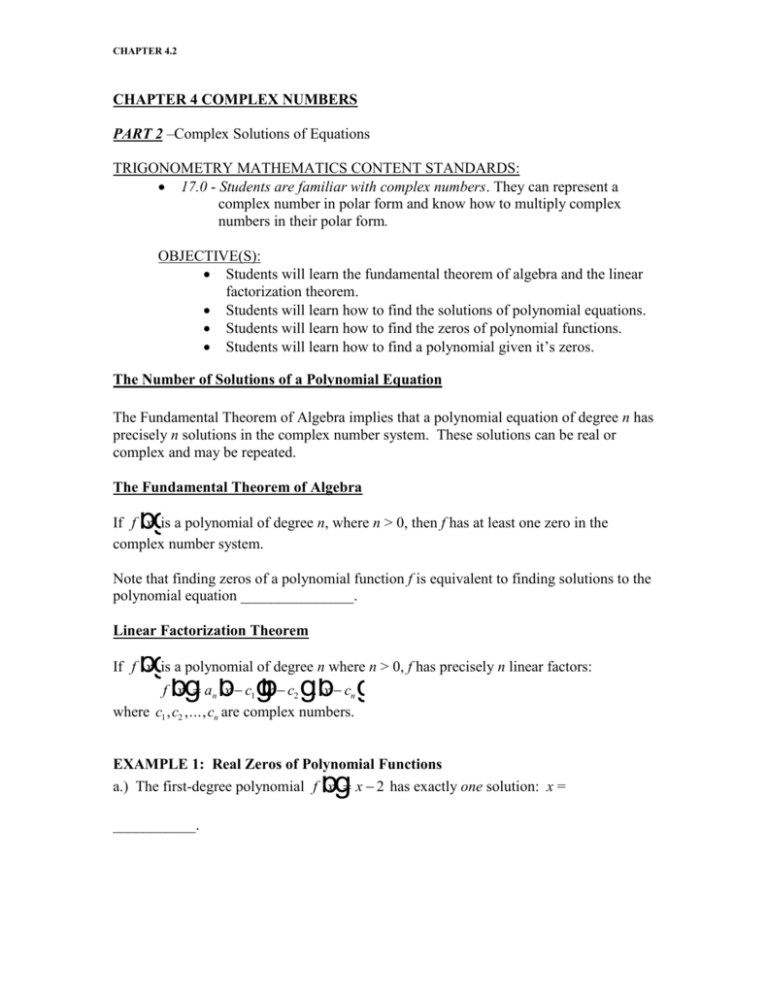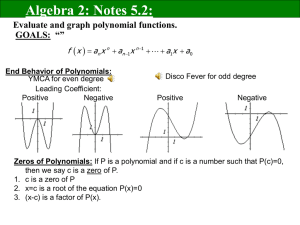Chapter 4_2 - Mira Costa High School
advertisement

CHAPTER 4.2 CHAPTER 4 COMPLEX NUMBERS PART 2 –Complex Solutions of Equations TRIGONOMETRY MATHEMATICS CONTENT STANDARDS: 17.0 - Students are familiar with complex numbers. They can represent a complex number in polar form and know how to multiply complex numbers in their polar form. OBJECTIVE(S): Students will learn the fundamental theorem of algebra and the linear factorization theorem. Students will learn how to find the solutions of polynomial equations. Students will learn how to find the zeros of polynomial functions. Students will learn how to find a polynomial given it’s zeros. The Number of Solutions of a Polynomial Equation The Fundamental Theorem of Algebra implies that a polynomial equation of degree n has precisely n solutions in the complex number system. These solutions can be real or complex and may be repeated. The Fundamental Theorem of Algebra bg If f x is a polynomial of degree n, where n > 0, then f has at least one zero in the complex number system. Note that finding zeros of a polynomial function f is equivalent to finding solutions to the polynomial equation _______________. Linear Factorization Theorem bg If f x is a polynomial of degree n where n > 0, f has precisely n linear factors: bg b gb gb g f x an x c1 x c2 ... x cn where c1 , c2 ,..., cn are complex numbers. EXAMPLE 1: Real Zeros of Polynomial Functions a.) The first-degree polynomial f x x 2 has exactly one solution: x = bg ___________. CHAPTER 4.2 b.) The second-degree equation x 2 6x 9 0 Second-degree equation. Factor. has exactly two solutions: x = __________ and x = _____________. (This is called a repeated solution.) c.) The third-degree polynomial equation x3 4x 0 Third-degree equation. Factor. Factor. has exactly three zeros: ______________, _________________, and _______________. CHAPTER 4.2 d.) The fourth-degree equation x4 1 = 0 Fourth-degree equation. = Factor. = Factor. has exactly four zeros: ________________, _________________, ________________, and _______________________. Every second-degree equation, ax 2 bx c 0 , has precisely two solutions given by the quadratic formula. x= The expression inside the radical, __________________, called the discriminant, and can be used to determine whether the solutions are real, repeated, or complex. 1. If b 2 4ac 0 , the equation has two complex solutions. 2. If b 2 4ac 0 , the equation has one repeated real solution. 3. If b 2 4ac 0 , the equation has two distinct real solutions. CHAPTER 4.2 EXAMPLE 2: Using the discriminant Use the discriminant to find the number of real solutions of each equation. a.) 4 x 2 20 x 25 0 For this equation, a = _____, b = ____, and c = _____. So, the discriminant is b 2 4ac = = = Because the discriminant is _________, there is ________ ___________________ __________ solution. b.) 13 x 2 7 x 2 0 For this equation, a = _____, b = ____, and c = _____. So, the discriminant is b 2 4ac = = = Because the discriminant is _________, there are ________ ___________________ solutions. c.) 5 x 2 8 x 0 For this equation, a = _____, b = ____, and c = _____. So, the discriminant is b 2 4ac = = = Because the discriminant is _________, there are ________ ___________________ __________ solutions. CHAPTER 4.2 Finding Solutions of Polynomial Equations EXAMPLE 3: Solving a Quadratic Equation Solve x 2 2 x 2 0 . Write complex solutions in standard form. Using a = ____, b = ____, and c = ____, you can apply the Quadratic Formula as follows. x b b 2 4ac 2a Quadratic Formula. Substitute ___ for a, ____ for b, and _____ for c. Simplify. Simplify. Write in standard form. Notice that two complex solutions are conjugates. That is, they are of the form ______________. This is not a coincidence, as indicated by the following theorem. DAY 1 Complex Solutions Occur in Conjugate Pairs If a bi, b 0 , is a solution of a polynomial equation with real coefficients, the conjugate __________is also a solution of the equation. Be sure you see that this result is true only if the polynomial has real coefficients. For instance, the result applies to the equation x 2 1 0 , but not to the equation x i 0 . CHAPTER 4.2 EXAMPLE 4: Solving a Polynomial Equation Solve x 4 x 2 20 0 . x 4 x 2 20 0 Write original equation. Partially factor. Factor completely. Setting each factor equal to zero yields the solutions x = ________, x = ________, x = _________, and x = _________. Finding Zeros of Polynomial Functions The problem of finding the zeros of a polynomial function is essentially the same problem as finding the solutions of a polynomial equation. For instance, the zeros of the polynomial function f x 3x 2 4 x 5 are simply the solutions of the polynomial equation 3x 2 4 x 5 0 CHAPTER 4.2 EXAMPLE 5: Finding the Zeros of a Polynomial Function Find all the zeros of f x x 4 3x 3 6 x 2 2 x 60 given that 1 3i is a zero of f. Because complex zeros occur in conjugate pairs, you know that _____________ is also a zero of f. This means that both and are factors of f. Multiplying these two factors produces x 1 3i x 1 3i = = = = Using long division, you can divide _______________________ into f to obtain the following. x 2 2 x 10 x 4 3x 3 6 x 2 2 x 60 bg = Therefore, you have: f x = and you can conclude that the zeros of f are x = ______________, x = ________________, x = _______________, and x = _________________. CHAPTER 4.2 EXAMPLE 6: Finding a Polynomial with Given Zeros Find a fourth-degree polynomial function with real coefficients that has -1, -1, and 3i as zeros. Because _____ is a zero and the polynomial is stated to have real coefficients, you know that the conjugate ______ must also be a zero. So, from the Linear Factorization Theorem, f x can be written as f x = ______________________________________________ For simplicity, let a = 1 to obtain f x = = EXAMPLE 7: Finding a Polynomial with Given Zeros Find a cubic polynomial function f with real coefficients that has 2 and 1-i as zeros, such that f 1 3 . Because 1 – i is a zero of f, so is _______________. So, f x = = = = = To find the value of a, use the fact that f 1 3 and obtain f 1 = = = So, a = ____ and it follows that f x = = DAY 2









